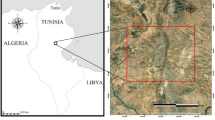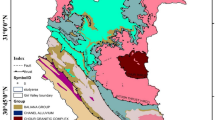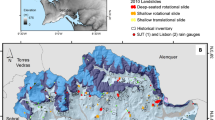Abstract
This paper analyses and applies a spatio-statistical failure rate (SSFR) technique for landslide susceptibility zonation in the Hindu Kush region, Pakistan. The study area (Shahpur valley) is located in the eastern Hindu Kush mountain system. In Shahpur valley, land sliding is a recurrent and costly extreme event. Geologically, this region constitutes the youngest mountain systems and almost every year landslide-induced losses are reported. The frequency and intensity of landslide events is expected to further increase in future due to rapid population growth over the fragile slopes, infrastructural development and deforestation. In order to achieve objectives of the study, data were obtained from both primary and secondary sources. In Shahpur valley, an inventory of the past 300 landslide events of various sizes has been identified and marked on a SPOT satellite image of 2.5 m resolution. In order to identify the influence of landslide triggering factors, such as geology, tectonic structures, land use, slope angle, slope aspect, roads and streams, a univariate SSFR technique has been tested and applied for calculating the susceptibility score in each class of the selected parameters. Based on factor maps and cumulative score, the landslide susceptibility zones have been developed and validated appearing to be significantly reflecting the pattern of the past landslide events.












Similar content being viewed by others
References
Akbar T A and Ha S R 2011 Landslide hazard zoning along Himalayan Kaghan valley of Pakistan – By integration of GPS, GIS, and remote sensing technology; Landslides 8(4) 527–540.
Allen S K, Cox S C and Owens I F 2011 Rock avalanches and other landslides in the central Southern Alps of New Zealand: A regional study considering possible climate change impacts; Landslides 8(1) 33–48.
Ayalew L and Yamagishi H 2005 The application of GIS-based logistic regression for landslide susceptibility mapping in the Kakuda–Yahiko Mountains, Central Japan; Geomorphology 65(1) 15–31.
Baig M S 1990 Structure and geochronology of Pre-Himalayan and Himalayan orogenic events in the Northwest Himalayan, Pakistan, with special reference to the Besham area; PhD Thesis, Oregon State University.
Conforti M, Pascale S, Robustelli G and Sdao F 2014 Evaluation of prediction capability of the artificial neural networks for mapping landslide susceptibility in the Turbolo river catchment (northern Calabria, Italy); Catena 113 236–250.
Dai F, Lee C and Ngai Y Y 2002 Landslide risk assessment and management: An overview; Eng. Geol. 64(1) 65–87.
Dhakal A S, Amada T and Aniya M 1999 Landslide hazard mapping and the application of GIS in the Kulekhani watershed, Nepal; Mountain Res. Develop. 19(1) 3–16.
Dichter D 1967 The North-West Frontier of West Pakistan: A Study in Regional Geography; Clarendon Press, Oxford.
Farooq M S 1997 Geotechnical study of landslide problems along the Murree, Muzaffarabad Road, Pakistan; PhD Thesis, University of Punjab.
Hussin H Y, Zumpano V, Reichenbach P, Sterlacchini S, Micu M, van Westen C and Bălteanu D 2016 Different landslide sampling strategies in a grid-based bi-variate statistical susceptibility model; Geomorphology 253 508–523, https://doi.org/10.1016/j.geomorph.2015.10.030.
Jehan N and Ahmad I 2006 Petrochemistry of asbestos bearing rocks from Skhakot–Qila ultramafic complex northern Pakistan; J. Health Stud. 39 75–83.
Kamp U, Owen L A, Growley B J and Khattak G A 2010 Back analysis of landslide susceptibility zonation mapping for the 2005 Kashmir earthquake: An assessment of the reliability of susceptibility zoning maps; Nat. Hazards 54(1) 1–25.
Kanungo D, Arora M, Sarkar S and Gupta R 2009 Landslide susceptibility zonation (LSZ) mapping – A review; J. S. Asian Stud. 2(1) 81–105.
Kazmi A, Lawrence R, Dawood H, Snee L and Hussain S 1984 Geology of the Indus suture zone in the Mingora–Shangla area of Swat; Geol. Bull. 17 127–144.
Kouli M, Loupasakis C, Soupios P and Vallianatos F 2010 Landslide hazard zonation in high risk areas of Rethymno prefecture, Crete Island, Greece; Nat. Hazards 52(3) 599–621.
Mirnazari J and Ahmad B B 2013 The generation of landslide susceptibility map using physical (experimental) method: A case study in Cheshme Kabud district, Iran; Int. J. Eng. Res. Technol. 2(2) 1–25.
Nandi A and Shakoor A 2010 A GIS-based landslide susceptibility evaluation using bivariate and multivariate statistical analyses; Eng. Geol. 110(1) 11–20.
Pareek N, Sharma M L and Arora M K 2010 Impact of seismic factors on landslide susceptibility zonation: A case study in part of Indian Himalayas; Landslides 7(2) 191–201.
Promper C, Puissant A, Malet J-P and Glade T 2014 Analysis of land cover changes in the past and the future as contribution to landslide risk scenarios; Appl. Geogr. 53 11–19.
Rahman A and Shaw R 2014 Floods in the Hindu Kush Region: Causes and Socio-Economic Aspects. Mountain Hazards and Disaster Risk Reduction; Springer, Tokyo, pp. 33–52.
Rahman A, Khan A N, Collins A E and Qazi F 2011 Causes and extent of environmental impacts of landslide hazard in the Himalayan region: A case study of Murree, Pakistan; Nat. Hazards 57(2) 413–434.
Rahman A, Khan A N and Collins A E 2014 Analysis of landslide causes and associated damages in the Kashmir Himalayas of Pakistan; Nat. Hazards 71(1) 803–821.
Rahman G, Rahman A, Samiullah and Collins A 2017 Geospatial analysis of landslide susceptibility and zonation in shahpur valley, eastern Hindu Kush using frequency ratio model; Proc. Pak. Acad. Sci. 54(3) 149–163.
Searle M P and Khan M A 1996 Geological Map of North Pakistan and Adjacent Areas of Northern Ladakh and Western Tibet, Scale 1:650,000; Oxford University, Oxford.
Sengupta A, Gupta S and Anbarasu K 2010 Rainfall thresholds for the initiation of landslide at Lanta Khola in north Sikkim, India; Nat. Hazards 52(1) 31–42.
Sudmeier-Rieux K, Jaquet S, Derron M-H, Jaboyedoff M and Devkota S 2012 A case study of coping strategies and landslides in two villages of Central-Eastern Nepal; Appl. Geogr. 32(2) 680–690.
Van Westen C J, Castellanos E and Kuriakose S L 2008 Spatial data for landslide susceptibility, hazard, and vulnerability assessment: An overview; Eng. Geol. 102(3) 112–131.
Van Westen C, Quan Luna B, Vargas Franco R, Malet J, Jaboyedoff M, Horton P and Kappes M 2010 Development of training materials on the use of geo-information for multi-hazard risk assessment in a mountainous environment; In: Paper presented at the Proceedings of the Mountain Risks International Conference, Firenze, Italy.
Wan S, Lei T and Chou T 2010 A novel data mining technique of analysis and classification for landslide problems; Nat. Hazards 52(1) 211.
Acknowledgements
This research would not have been possible without the technical support of our colleagues Mr Liaqat Ali Khan and Mr Alamsher Bacha. We thank them for giving valuable ideas and support in the application of GIS.
Author information
Authors and Affiliations
Corresponding author
Additional information
Corresponding editor: Navin Juyal
Rights and permissions
About this article
Cite this article
Rahman, G., Rahman, Au., Ullah, S. et al. Spatial analysis of landslide susceptibility using failure rate approach in the Hindu Kush region, Pakistan. J Earth Syst Sci 128, 59 (2019). https://doi.org/10.1007/s12040-019-1066-0
Received:
Revised:
Accepted:
Published:
DOI: https://doi.org/10.1007/s12040-019-1066-0




